Many skinny guys dream of building bulging biceps. But speaking from experience, these muscles can also be notoriously difficult to bulk up if you don’t know what you’re doing. Below, I explain how many exercises you need for an effective biceps program.
Generally speaking, 3 or 4 different biceps exercises are sufficient to build larger arms. These should include a combination of direct isolation and indirect compound exercises. Additionally, exercises should be carefully selected to work all regions of the biceps muscles.
This post shares my research and experience to help you build sleeve-busting arms.
Let’s go!

- Key Takeaways
- How Many Exercises Are Required To Build Big Biceps?
- Recommended Number Of Bicep Exercises Per Workout
- Choosing The Ideal Bicep Exercises
- How Many Biceps Exercises Bodybuilders Do Per Workout
- Ideal Number Of Biceps Workouts Per Week
- Optimal Number Of Sets And Reps To Increase Biceps Mass
- Rule Of Halves To Account For Indirect Biceps Sets
- Ideal Training Frequency For Biceps
- Why Different Exercises Are Needed To Bulk Up The Biceps
- Best Exercises For Huge Biceps
- Conclusion
Key Takeaways
- Just a handful (2-4) of exercises are enough to drive efficient bicep growth.
- Complete 2-4 biceps exercises per workout depending on training level (includes isolation and compound lifts).
- Choose the right ratio of compound to isolation biceps movements (I recommend a 25/75 split).
- Aim for 10-20 total bicep sets per week (beginners start on the lower end of the spectrum).
- Focus on doing 8-15 reps per set.
How Many Exercises Are Required To Build Big Biceps?
You can also check out Jeff Nippards explanation of how to build big biceps!
I’ve been the skinny newbie who performed every biceps exercise in the books, hoping that this would lead to exponential biceps growth.
But with experience, I’ve come to realize that this is one of the biggest arm-building mistakes you can make. More is not always better.
In fact, 2-4 carefully selected curling and pulling movements from the list below are sufficient to promote biceps hypertrophy (growth):
- Incline dumbbell curl.
- Supinated dumbbell curl.
- Concentration curl.
- Spider curl.
- Wide-grip curl.
- Hammer curl.
- Overhand reverse curl.
- Dumbbell, barbell, and cable rows.
- Pull-ups and chin-ups.
In support of this, 75% of Quora trainers agree that 2 to 4 exercises are all you need to drive biceps hypertrophy (recommended biceps exercises can be found below).

Next, I’ll explain how to choose the right number and selection of biceps movements to drive the most efficient growth.
Recommended Number Of Bicep Exercises Per Workout
Generally speaking, a beginner should begin working the biceps with 2 exercises per workout. This can increase to 3-4 exercises per workout to maximize arm growth when the individual becomes stronger.
Additionally, your workout split can affect how many bicep exercises you complete per workout, as follows:
| Training Slit | Number Of Training Days Per Week | Typical Number Of Biceps Exercises Per Workout |
|---|---|---|
| Full-body | 3 | 2-3 |
| Upper-lower body | 4 | 2-3 |
| Muscle group | 5 | 4 |
| Push-pull-legs | 6 | 5 |
Note: these are generalized recommendations and inclusive of compound and isolation movements. The exact number of recommended biceps exercises also depends on the goal and training level.
In support of this, 67% of Reddit users agreed that 2 to 4 different exercises per workout are optimal for a trained lifter.
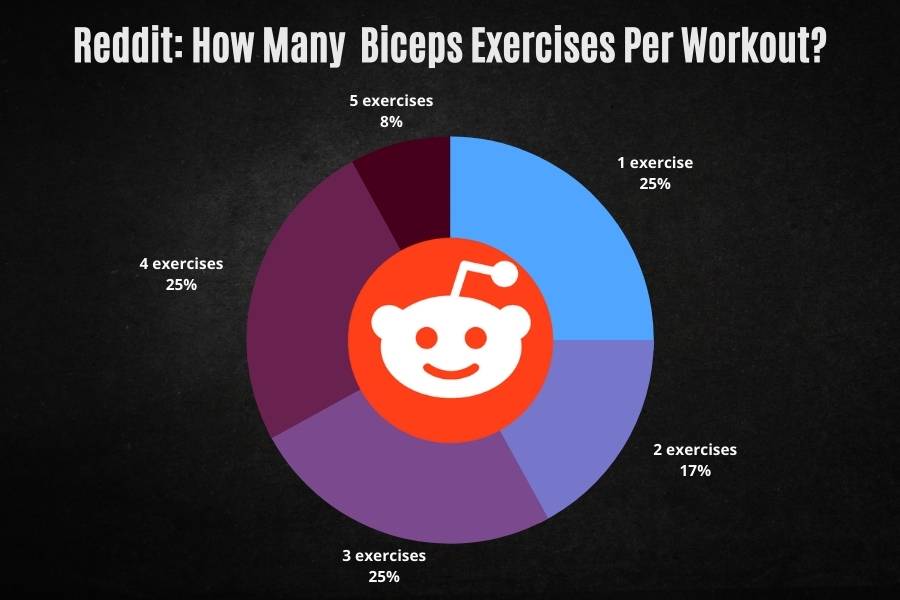
These recommendations are based on the assumption that you’re training your biceps with 2 or 3 workouts per week (which you should be doing to drive maximal bicep growth).
Next, I’ll teach you how to choose the right selection of biceps exercises.
Choosing The Ideal Bicep Exercises
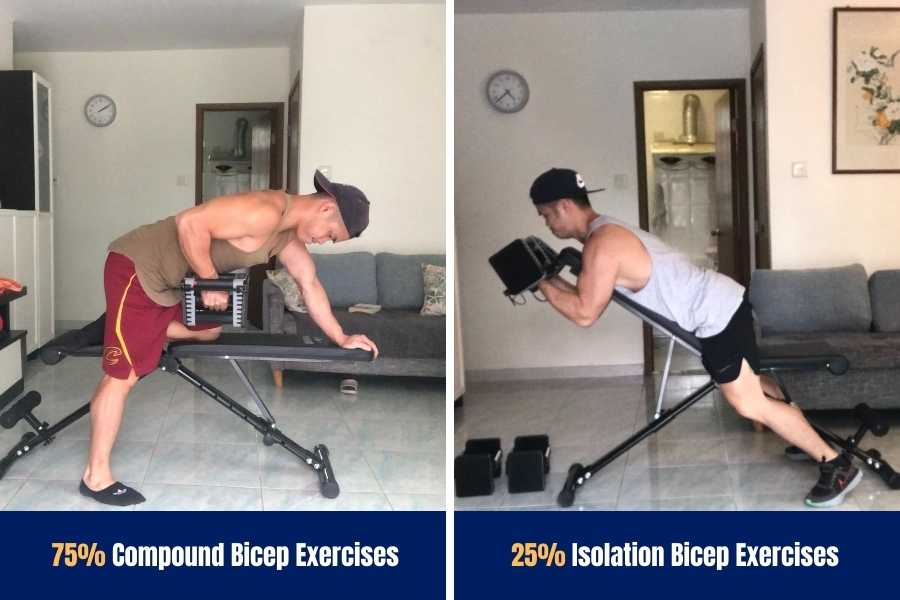
Choosing 2-4 biceps exercises is enough to grow bigger arms. But for the most efficient growth, you need to choose the right combination of movements.
Your selection should ideally include a mix of compound-type and isolation-type movements. I recommend a 75:25 ratio (compound:isolation).
If, for example, you’re doing 4 bicep movements per workout, you could do the following exercises:
- Barbell row (compound).
- Upright row (compound).
- Lat pull-down (compound).
- Supinated bicep curl (isolation).
How Many Biceps Exercises Bodybuilders Do Per Workout
Bodybuilders like Chris Bumstead (IFBB bodybuilder and Mr Olympia) will usually do around 3 direct isolation-type bicep exercises (like curl variations) per workout. In addition, they’ll also do a variety of indirect compound-type pulling lifts (like rows and pull-ups)
You can find Chris’s arm workout here.
But this kind of training volume is too intense for most people and will likely lead to overtraining.
Remember- your muscles grow during rest and not during the workout itself. So it’s imperative you don’t overtrain them with super-intense workouts.
Start with 2 different exercises instead, making sure they each target distinct regions of the biceps. Then progress on to 3 and then 4 different exercises when your biceps have adapted.
This will take around 1 to 2 years of consistent training, respectively.
Ideal Number Of Biceps Workouts Per Week
Generally speaking, 1 to 4 bicep workouts per week are sufficient to build bigger arms. This training frequency allows for the biceps to be targeted with 10-20 total sets, which is the general recommended volume for optimal hypertrophy.
To grow any given muscle, it’s important to give it 10-20 weekly sets. How you reach this target depends on your training split, as follows:
- Full-body split. Usually involves 3-4 workouts per week, each of which targets the entire body including the back and biceps.
- Upper-lower-body split. Usually involves 2 upper body workouts per week, each of which targets the back and biceps.
- Muscle-group split. Usually involves 1-2 back and biceps workouts per week
- Push-pull-legs split. Usually involves 2 pulling workouts per week, each of which targets the back and biceps.
For more information on how many sets and reps you should complete to grow your arms, you can check out my guide on training volume for biceps.
Optimal Number Of Sets And Reps To Increase Biceps Mass
The average beginner should aim to complete a minimum of 10 sets of biceps exercises per week. Each set should comprise 8 to 15 repetitions using a weight that fatigues the individual’s muscles. This should provide a sufficient training volume to drive biceps hypertrophy and mass development.
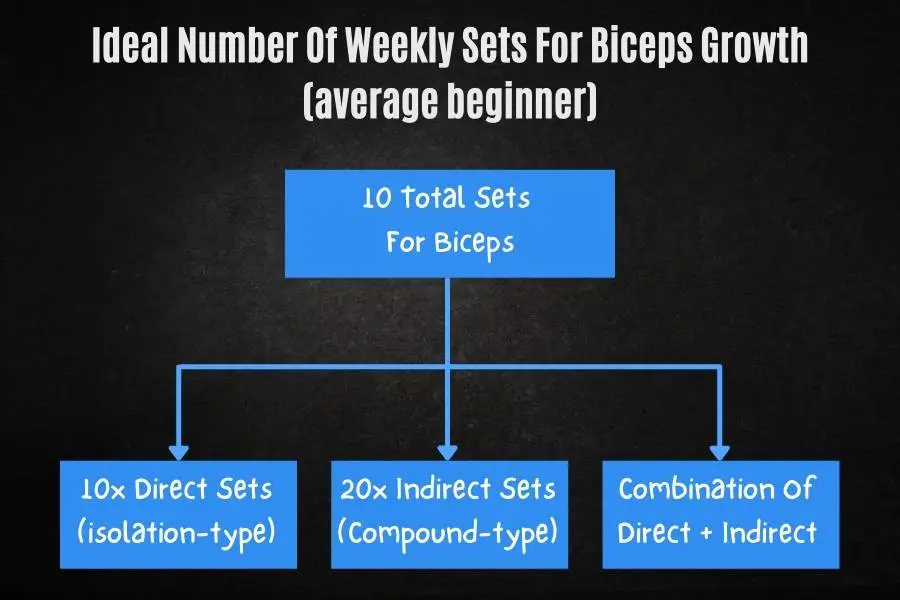
Training volume simply refers to the total number of sets, reps, and training frequency you complete every week.
Sticking to a predefined volume is the best way to guarantee a consistent hypertrophy stimulus.
Generally speaking, 10 direct sets per muscle group per week is recommended for hypertrophy in beginners.
Each set should always stay in the region of 8-15 reps per set. Speaking from experience, this is the ideal rep range for arms.
The weight should always challenge you for those 8-15 reps and also allow you to lift with proper form.
Rule Of Halves To Account For Indirect Biceps Sets
Biceps training usually comes from isolation-type lifts like the bicep curls and their variations.
But chances are you’re also doing indirect bicep work throughout the week in the form of compound pulling movements like the row, pull-up, lat-pulldown, etc.
If so, then you need to account for these in your 10-set weekly target.
How do you account for sets of indirect biceps work?

I use the rule of halves- every 2 sets of indirect bicep training equates to 1 set of direct bicep training.
For example: 3 weekly sets of biceps curl is the equivalent of 6 weekly sets of pull-ups (for biceps).
After around 6-12 months of consistent biceps training, your arms will become stronger and you can increase to 12 total weekly sets, and so on.
But you should stop increasing sets when you reach 20+ direct sets of bicep work per week.
Here, you’ll unlikely get any more added benefits. This is a bodybuilder-level of training volume and far too much for most people.
Focus on overloading by increasing weight or decreasing lifting tempo instead.
Are you a skinny beginner new to working out? You may be interested in my telltale signs that you’re building muscle
Ideal Training Frequency For Biceps
Most beginners should train their biceps with at least 2 workout days per week. When the biceps become stronger, the person can increase to 3 arm days. Completing the optimal training frequency gives the biceps a sufficient growth stimulus whilst also reducing the risk of overtraining.

Why a minimum of 2 biceps days per week?
2 studies explain why.
This 2017 study found a dose-response relationship between the number of weekly sets and muscle growth. In other words, the more sets you complete the more your biceps will grow.
But there’s also a caveat.
This 2018 research paper found that doing more than 5 sets per workout leads to significantly diminished returns. In other words, doing too many sets per workout results in so-called “wasted sets”.
Taken together, this suggests you should aim to complete your 10 weekly sets over 2 training days to give your biceps the perfect hypertrophy stimulus (rather than cramming all your sets into one long-ass workout).
Additionally, those training days should be non-consecutive.
In other words, you should leave 24-48 hours of rest between workouts.
This is important for 2 reasons:
- Muscle growth happens at rest. Denying your biceps rest will negatively impact their growth.
- Allows recovery for progressive overload. You can’t push yourself with heavier weights if you’re biceps aren’t fully recovered.
It’s for these reasons that it’s not recommended to train your biceps every day.
Only when your biceps have adapted to your current training volume should you increase to 3 bicep days per week.
You can tell when the time is right when your biceps are able to fully recover between workouts (no muscle soreness or lack of strength).
For a complete full-body program that can also help you build bigger biceps, you can check out my home workout routine.
Why Different Exercises Are Needed To Bulk Up The Biceps
It is important to perform multiple exercises to build bigger biceps. A variety of different movements will allow an individual to target the individual regions of the collective biceps muscle. These regions include the long and short heads of the biceps brachii, brachialis, and brachioradialis.

Here’s how each muscle functions and how it contributes to the overall look of your biceps:
- Biceps brachii long head. This muscle serves as an elbow flexor (bringing the forearms towards the shoulder) and wrist supinator (rotate your right hand clockwise and you’ll feel your right biceps contract). It runs along the entire outer-top surface of the upper arm. The long head contributes to your biceps peak (aka the bulge) as well as the length of your biceps. It’s activated by normal underhand-grip curling.
- Biceps brachii short head. The role of this muscle is for elbow flexion and wrist supination. It runs along the inner-top surface of the upper arms, next to the long-head. The short head contributes to the biceps peak as well as width, thickness, and girth. It’s activated by normal underhand-grip curling movements.
- Brachialis. This muscle is used purely for elbow flexion and it’s around 50% stronger than biceps brachii at flexing your arms. It runs beneath the biceps brachii. Whilst it won’t directly contribute to biceps peak, it does add overall volume to your upper arms. It’s activated by neutral-grip (palm facing towards the body) pulling and curling.
- Brachioradialis. This muscle is a wrist supinator and elbow flexor. It bridges the bottom of the upper arm to the middle of the forearm. The brachioradialis contributes to the thickness of the upper forearm. It’s activated by neutral-grip and overhand-grip curling and pulling.
By working your biceps with multiple varieties of exercises, you target them at different angles for complete biceps growth (hypertrophy).
Best Exercises For Huge Biceps
Here’s a complete selection of exercises that work all your biceps muscles. Work on 3 at a time (1 from each category):
| Long Head Biceps Exercises | Short Head Biceps Exercises | Brachialis Exercises | Brachioradialis Exercises |
|---|---|---|---|
| Incline dumbbell curl | Spider curl | Dumbbell/barbell row | Overhand reverse curl |
| Supinated dumbbell curl | Wide-grip curl | Pull-ups/chin-ups | Pull-up |
| Concentration curl | Concentration curl | Hammer curl | Hammer curl |
1) Incline dumbbell curl.
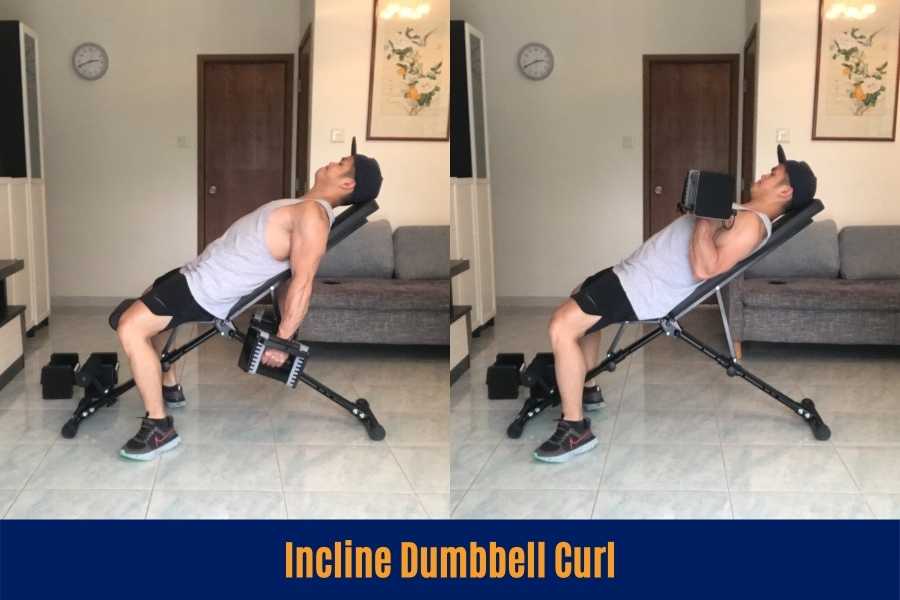
Lay on a 45° incline bench and hold dumbbells below the torso using a neutral grip (palms facing the body). Curl the dumbbells up whilst supinating your wrists (rotating them upwards). Lower the dumbbells slowly to complete a repetition. I like to contract my triceps at the end of the down phase to put my biceps in a deficit position and get a good pump.
2) Supinated dumbbell curl.

Use a neutral grip to hold pair of dumbbells on either side of your body. This can be done whilst standing or seated. Curl the dumbbells and supinate your wrists to get a really good contraction in the biceps. Bend your knees a bit, sit back, and keep a straight back to prevent cheating. I offset my grip so that my thumbs rest on the outer edge of the dumbbell handle and my pinky finger rests in the middle of the handle. This helps with wrist supination.
You can check out my other post for bicep curl weight standards!
3) Concentration curl.
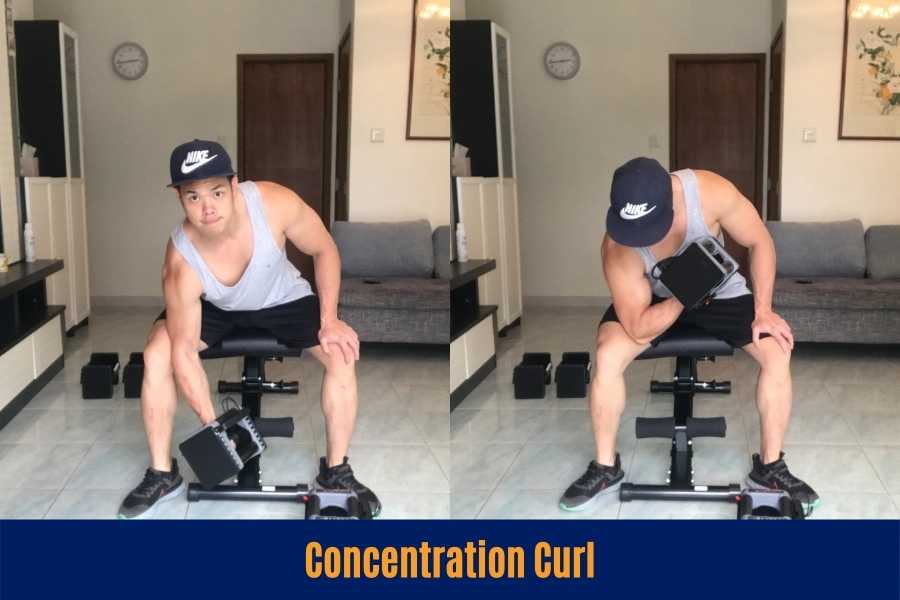
Sit on a bench with your feet planted firmly on the floor. Open your legs to allow space to rest the triceps of one arm on the inner thigh of the same side. Curl the dumbbell upwards whilst maintaining a firm thigh-tricep connection. This prevents you from using momentum to help you curl the dumbbell. As a result, your curling strength will improve.
4) Spider curl.

Lay chest-down on a 45° incline bench and hold a pair of dumbbells in front of you using a neutral grip. Your upper arms should be pointing toward the floor. Curl the dumbbells up and supinate your wrists. Brace your core, keep your chin tucked into your neck, and make sure you come to a dead stop before curling the dumbbells back up. This will maximize biceps contraction.
5) Wide-grip curl.
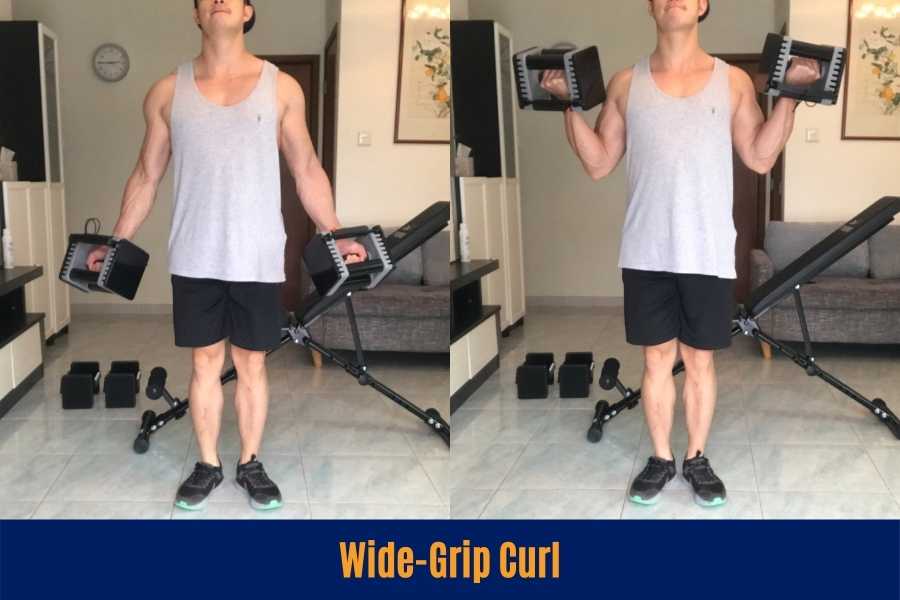
This is the same as the conventional supinated dumbbell curl. The only variation is in your grip width. Rather than curling with your hands at a shoulder-width distance, widen the grip so that your hands are just outside of your shoulders. This will emphasize the biceps brachii short head. Result? Bulging biceps with a strong peak and wide girth!
6) Dumbbell/barbell row.
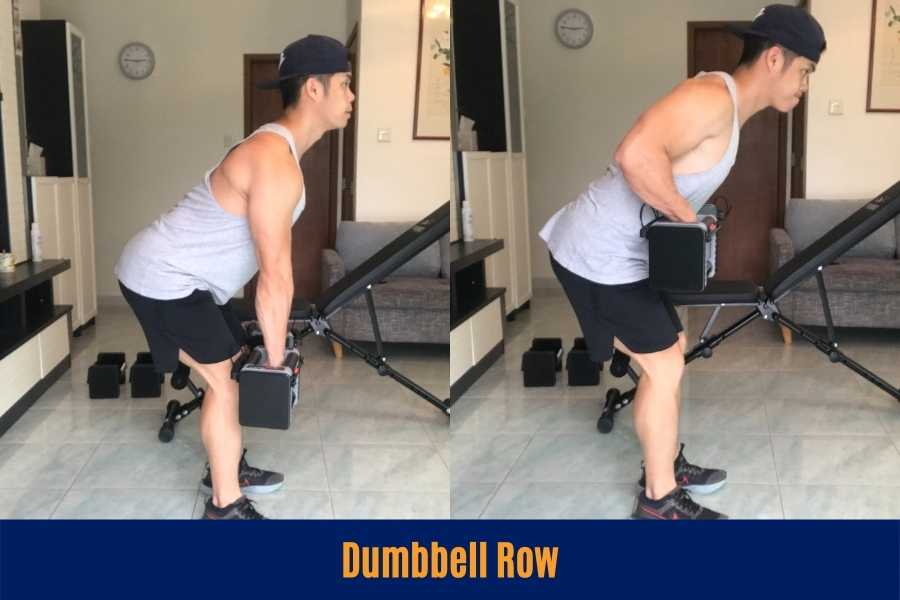
Stand and hold dumbbells or a barbell in front of you using an overhand grip. Lean forward so your back is almost 45° to the floor (keep your lower back straight though). Bending your knees slightly and sticking your butt out can help you maintain this position. Pull the dumbbell/barbell towards your navel and hold the contraction for a split second before slowly lowering the weight. Keep your grip a shoulder-width distance for maximal brachialis activation!
You can check out my other post for dumbbell row weight standards!
7) Pull-ups.
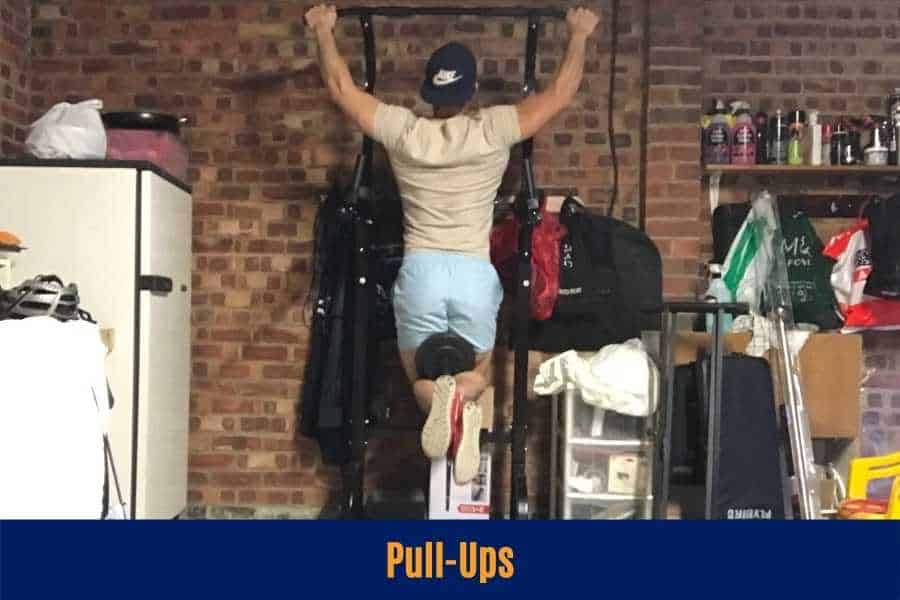
Hold the pull-up bar using an overhand grip with the hands at a shoulder-width distance. Retract the shoulder blades and pull yourself up. This is one of the best moves to do for a larger brachialis and brachioradialis. If you want to maximize biceps growth, make sure the bar touches your chest such that your forearms touch your biceps.
You can check out my other post for weighted pull-up standards!
8) Hammer curl.

Hold a pair of dumbbells in each hand using a neutral grip. Slowly curl them upwards before lowering them again, just like a normal bicep curl. This is one of the simplest exercises to drive brachialis and brachioradialis growth. It’s a similar movement to the pull-up (in terms of biceps activation).
9) Overhand reverse curl.
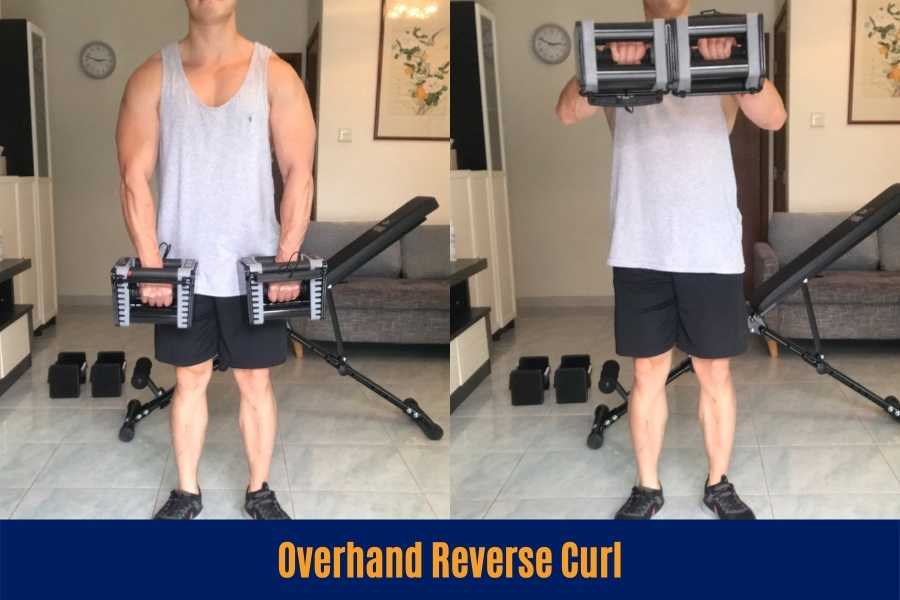
This movement is exactly the same as the normal bicep curl. But instead of holding the dumbbell/barbell with an underhand grip, you go for an overhand grip. This shifts the emphasis onto the brachioradialis. As a result, you’ll develop musculature on the upper forearm where it meets the biceps.
Conclusion
For most people, the number of exercises you should do for biceps growth usually falls within the 2-4 range.
This small selection of movements is sufficient to drive hypertrophy if you choose a combination of compound and isolation-type movements and apply the correct training volume (sets, reps, weight, and frequency).
You may also be interested in the downloadable Kalibre Blueprint PDF which details exactly how I gained 40lbs of lean muscle (it’s 100% free!). It details the exact exercises and nutrition (with printables) I used to go from skinny to ripped!


